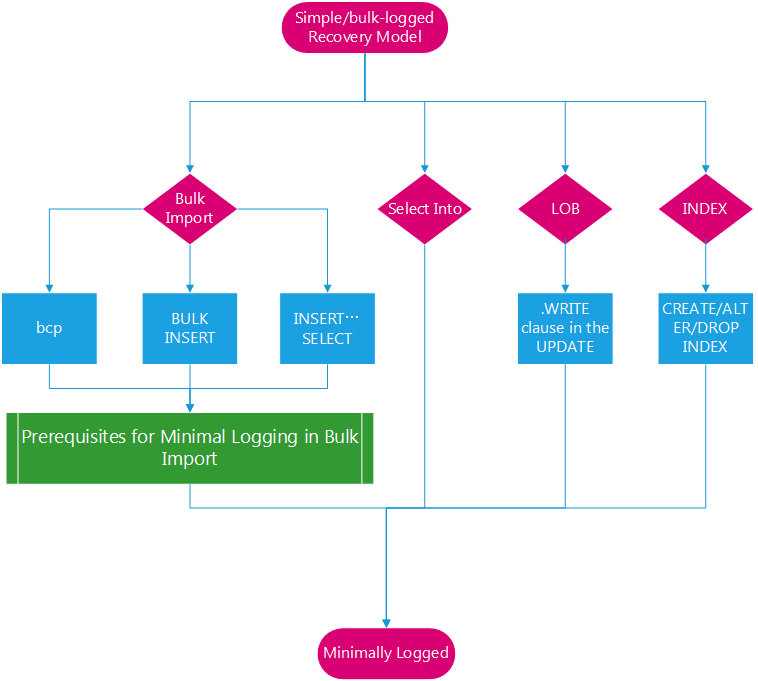4. 跟踪标记 (Trace Flag) 610 对索引组织表(IOT)最小化日志
跟踪标记:610
功能:
- 用批量导入操作(Bulk Import Operations)加载数据时,对于索引组织表(即有聚集索引的表) 最小化日志;

上图为simple/bulk-logged恢复模式下,最小化日志的几种操作,其中包含了批量导入操作,而批量导入操作的最小化日志有一些前提条件,概括如下:
1. 目标表未用于复制;
2. 目标表上指定了TABLOCK;
3. 目标表上的索引情况,这条规则最复杂,见下表:

从表格可以看出:
(1) 堆表的数据页一直可以最小化日志;
(2) 聚集索引和非聚集索引,一直是完全记录日志的,除了在空表的情况下(即索引也是空的),第一个批次(batch)导入的数据可以最小化日志,从第二个批次(batch)起就不再是最小化日志,原因就是第一个批次(batch)结束后,就不再是空表了,跟踪标记610也正是因为这个而出现;
用途:
- 提升索引组织表(即有聚集索引的表)批量导入操作的性能;
备注:
(1) 从SQL Server 2008 开始,引入了跟踪标记610;
(2) 从SQL Server 2016开始,跟踪标记610所具备的功能,已经被数据库引擎所默认,不需要再额外手动开启跟踪标记 (同样的,也就没有开关去关闭) ;
测试:观察[Log Record Length]这列的变化和区别
-- Set Recover model to SIMPLE/BULK_LOGGED ALTER DATABASE testing SET RECOVERY SIMPLE; /**************************START of CREATE TEST TABLES******************************/ USE testing GO IF OBJECT_ID('SrcHeap') IS NOT NULL DROP TABLE SrcHeap; IF OBJECT_ID('TarHeap') IS NOT NULL DROP TABLE TarHeap; IF OBJECT_ID('TarTable') IS NOT NULL DROP TABLE TarTable; CREATE TABLE SrcHeap (col1 INT ,col2 CHAR(4000),col3 CHAR(1000) ) ; CREATE TABLE TarHeap( col1 INT ,col2 CHAR(4000),col3 CHAR(1000) ) ; CREATE TABLE TarTable (col1 INT ,col2 CHAR(4000),col3 CHAR(1000) ); create clustered index IX_01 on TarTable(col1); --Insert row into source table WITH Nums (col) AS ( SELECT 1 col UNION ALL SELECT col + 1 FROM Nums WHERE col+1 <= 10000 ) INSERT INTO SrcHeap(col1,col2,col3) SELECT col,replicate('A',4000),replicate('B',1000) FROM Nums OPTION (MAXRECURSION 10000) /**************************END of CREATE TEST TABLES******************************/ /**************************START of HEAP testing******************************/ --Insert rows to Target Table with (TABLOCK) Minimally logged INSERT INTO TarHeap WITH(TABLOCK) SELECT * FROM SrcHeap -- Check Log Entries SELECT TOP 10 operation [MINIMALLY LOGGED OPERATION],context, [log record fixed length], [log record length], AllocUnitId, AllocUnitName FROM fn_dblog(null, null) WHERE allocunitname='dbo.TarHeap' ORDER BY [Log Record Length] DESC; --Note That [Log Record length] is small --Insert rows to Target Table without (TABLOCK) fully logged INSERT INTO TarHeap SELECT * FROM SrcHeap WITH(NOLOCK); -- Check Log Entries SELECT TOP 10 operation [FULLY LOGGED OPERATION],context, [log record fixed length], [log record length], AllocUnitId, AllocUnitName FROM fn_dblog(null, null) WHERE allocunitname='dbo.TarHeap' ORDER BY [Log Record Length] DESC; --Note That [Log Record length] is big /**************************END of HEAP testing******************************/ /**************************START of INDEXED TABLES testing WITHOUT 610******************************/ --Insert rows to Target Table with clustered index and trace flag 610 off --Fully logged from second batch --First Batch INSERT INTO TarTable WITH(TABLOCK) SELECT * FROM SrcHeap WITH(NOLOCK); CHECKPOINT; --first batch with or without 610 select * FROM fn_dblog(null, null) WHERE allocunitname LIKE '%TarTable%' --4582 rows and operation = 'LOP_INSERT_ROWS'--0 rows --Second Batch INSERT INTO TarTable WITH(TABLOCK) SELECT col1+10000,col2,col3 FROM SrcHeap WITH(NOLOCK); CHECKPOINT --from second batch without 610, tested twice SELECT * FROM fn_dblog(null, null) WHERE allocunitname LIKE '%TarTable%' --114308 rows, 114293 rows and operation = 'LOP_INSERT_ROWS'--20090 rows, 20088 rows and (context = 'LCX_CLUSTERED' --10000 rows (actual rows) or context = 'LCX_INDEX_INTERIOR' --44 rows (description) ) ORDER BY [Log Record Length] DESC /**************************END of INDEXED TABLES testing WITHOUT 610******************************/ CHECKPOINT; GO DBCC TRACEON(610); TRUNCATE TABLE TarTable; GO /**************************START of INDEXED TABLES testing WITH 610******************************/ --Insert rows to Target Table with clustered index and trace flag 610 on --Minimally logged for all batches --with 610 enables + with TABLOCK, the first bath logged less than second batch --with 610 enables + without TABLOCK, the first batch processes as same as begining with second batch INSERT INTO TarTable --WITH(TABLOCK) SELECT * FROM SrcHeap WITH(NOLOCK); INSERT INTO TarTable --WITH(TABLOCK) SELECT col1+10000,col2,col3 FROM SrcHeap WITH(NOLOCK); CHECKPOINT --from second batch with 610 SELECT * FROM fn_dblog(null, null) WHERE allocunitname LIKE '%TarTable%' --54995 rows and operation = 'LOP_INSERT_ROWS'--10090 rows and (context = 'LCX_CLUSTERED' --0 rows (autual rows) or context = 'LCX_INDEX_INTERIOR' --44 rows (description) ) ORDER BY [Log Record Length] DESC /**************************END of INDEXED TABLES testing WITH 610******************************/ DBCC TRACEOFF(610) DBCC TRACESTATUS(-1)
小结:
(1) 条件允许情况下,批量导入操作还是跑在堆表上性能最佳;
(2) 跟踪标记610被开启后,对于聚集索引,只有新分配的数据页才会最小化日志,数据插入已有数据页,仍然是fully logged,所以建表时还得考虑聚集索引键的选择;
(3) 跟踪标记610被开启后,对于非聚集索引,并不一定可以最小化日志,这取决于查询优化器对执行计划的选择;
(4) 跟踪标记610被开启后,对于堆表,仍然要指定TABLOCK;对于索引组织表,可不指定TABLOCK,也仍然可以最小化日志,每个批次(batch)最小化日志方式一致;
参考:
Operations That Can Be Minimally Logged
https://technet.microsoft.com/en-us/library/ms191244(v=sql.105).aspx
Prerequisites for Minimal Logging in Bulk Import
https://technet.microsoft.com/en-us/library/ms190422(v=sql.105).aspx
DBCC TRACEON - Trace Flags (Transact-SQL)
The Data Loading Performance Guide
https://technet.microsoft.com/en-us/library/dd425070(v=sql.100).aspx


